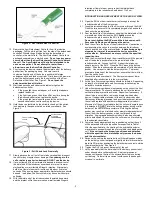
Azur
Peripheral Coil System
Framing Coil (Detachable)
Instructions for Use
DEVICE DESCRIPTION
The Detachable Azur Peripheral Coil System Framing Coil (Azur
system) consists of a coil implant attached to a delivery system.
The coils are platinum coils. The delivery pusher is powered by
an Azur Detachment Controller to selectively detach the coils.
The Azur Detachment Controller is provided separately.
The Azur system is available in a broad range of coil diameters
and lengths. The coil must be delivered only through a wire-
reinforced microcatheter with the minimum inner diameter
specified.
Table 1
INDICATIONS FOR USE
The Azur system is intended to reduce or block the rate of blood
flow in vessels of the peripheral vasculature. It is intended for use
in the interventional radiologic management of arteriovenous
malformations, arteriovenous fistulae, aneurysms, and other
lesions of the peripheral vasculature.
This device should only be used by physicians who have
undergone training in the use of the Azur system for embolization
procedures as prescribed by a representative from Terumo
or a
Terumo-authorized distributor.
CONTRAINDICATIONS
Use of the Azur system is contraindicated in any of the following
circumstances:
When superselective coil placement is not possible.
When end arteries lead directly to nerves.
When arteries supplying the lesion to be treated are not
large enough to accept emboli.
When the A-V shunt is larger than the coil.
In the presence of severe atheromatous disease.
In the presence of vasospasm (or likely onset of
vasospasm).
POTENTIAL COMPLICATIONS
Potential complications include, but are not limited to: hematoma
at the site of entry, vessel/aneurysm perforation, unintended
parent artery occlusion, incomplete filling, vascular thrombosis,
hemorrhage, ischemia, vasospasm, edema, coil migration or
misplacement, premature or difficult coil detachment, clot
formation, revascularization, post-embolization syndrome, and
neurological deficits including stroke and possibly death.
The physician should be aware of these complications and
instruct patients when indicated. Appropriate patient
management should be considered.
REQUIRED ADDITIONAL ITEMS
Azur Detachment Controller
Wire-reinforced microcatheter with distal tip RO marker,
appropriately sized
Guide catheter compatible with microcatheter
Steerable guidewires compatible with microcatheter
2 rotating hemostatic Y valves (RHV)
1 three-way stopcock
Sterile saline
Pressurized sterile saline drip
1 one-way stopcock
WARNINGS AND PRECAUTIONS
Caution: Federal law (USA) restricts this device to sale by or
on the order of a physician.
The Azur system is supplied sterile and non-pyrogenic
unless package is opened or damaged.
This device is intended for single use only. Do not reuse,
reprocess or resterilize. Reuse, reprocessing or
resterilization may compromise the structural integrity of the
device and/or lead to device failure which, in turn, may result
in patient injury, illness, or death. Reuse, reprocessing, or
resterilization may also create a risk of contamination of the
device and/or cause patient infection or cross-infection,
including, but not limited to, the transmission of infectious
disease(s) from one patient to another. Contamination of the
device may lead to injury, illness or death of the patient.
Angiography is required for pre-embolization evaluation,
operative control, and post-embolization follow up.
Do not advance the delivery pusher with excessive force.
Determine the cause of any unusual resistance, remove the
Azur system, and check for damage.
Advance and retract the Azur system slowly and smoothly.
Remove the entire Azur system if excessive friction is noted.
If excessive friction is noted with a second Azur system,
check the microcatheter for damage or kinking.
Due to the delicate nature of the coils, the tortuous vascular
pathways that lead to certain lesions, and the varying
morphologies of the vasculature, a coil may occasionally
stretch while being maneuvered. Stretching is a precursor to
potential coil breakage and migration.
If repositioning is necessary, take special care to retract the
coil under fluoroscopy in a one-to-one motion with the
delivery pusher. If the coil does not move in a one-to-one
motion with the delivery pusher, or if repositioning is difficult,
the coil may have become stretched and could possibly
break. Gently remove and discard the entire device.
If a coil must be retrieved from the vasculature after
detachment, do not attempt to withdraw the coil with a
retrieval device, such as a snare, into the delivery catheter.
This could damage the coil and result in device separation.
Remove the coil, microcatheter, and any retrieval device
from the vasculature simultaneously.
Delivery of multiple coils is usually required to achieve the
desired occlusion of some vasculatures or lesions. The
desired procedural endpoint is usually angiographic
occlusion. The filling properties of the coils facilitate
angiographic occlusion and reduce the need to tightly pack
with numerous coils.
Tortuosity or complex vessel anatomy may affect accurate
placement of the coil.
Always advance an appropriately sized guidewire through
the microcatheter after detaching the coil and removing the
pusher to ensure that no part of the coil remains within the
microcatheter.
The long-term effect of this product on extravascular tissues
has not been established so care should be taken to retain
this device in the intravascular space.
Always ensure that at least two Azur Detachment Controllers
are available before starting an Azur system procedure.
The coil cannot be detached with any power source other
than an Azur Detachment Controller.
Do NOT place the delivery pusher on a bare metallic
surface.
Always handle the delivery pusher with surgical gloves.
Do NOT use in conjunction with radio frequency (RF)
devices.
Coil Type
Minimum
Microcatheter I.D.
inches
mm
Azur Detachable 18
0.021
0.53
Azur Detachable 35
0.038
0.97























